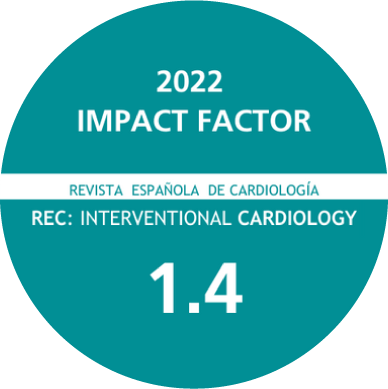Artículos originales \ Scientific Letters
One-year outcomes with the Firehawk sirolimus-eluting stent and biodegradable polymer guided by intravascular ultrasound
Hemodinamica – Cardiologia Intervencionista, Hospital Cardiologico Costantini, Curitiba, Brazil
DOI: https://doi.org/10.24875/RECICE.M24000439
Disponible online: 11/04/2024
Use of cutting or scoring balloons in patients with native coronary artery disease: systematic review and meta-analysis
aServicio de Cardiología, Hospital Universitari i Politècnic La Fe, Valencia, Spain
bCentro de Investigación Biomédica en Red de Enfermedades Cardiovasculares (CIBERCV), Spain
DOI: https://doi.org/10.24875/RECICE.M24000448
Disponible online: 08/04/2024
Catheter-directed therapies for patients with acute pulmonary embolism: results from a multiparametric follow-up protocol
Cardiology Department, Hospital de Santa Marta, Lisbon, Portugal
◊ Both first and second author contributed equally to this article.
DOI: https://doi.org/10.24875/RECICE.M24000447
Disponible online: 04/03/2024
Computed tomography C-arm angulations for planning coronary cannulation after TAVI
aServicio de Cardiología, Hospital Clínico Universitario de Santiago de Compostela, Instituto de Investigaciones Sanitarias (IDIS), Santiago de Compostela, A Coruña, Spain
bCentro de Investigación Biomédica en Red de Enfermedades Cardiovasculares (CIBERCV), Spain
DOI: https://doi.org/10.24875/RECICE.M24000440
Disponible online: 27/02/2024
Predictors of late pacemaker implantation following TAVI
aServicio de Cardiología, Hospital Universitario de Canarias, San Cristóbal de La Laguna, Tenerife, Spain
bFacultad de Ciencias de la Salud, Sección de Medicina, Universidad de La Laguna, San Cristóbal de La Laguna, Tenerife, Spain
DOI: https://doi.org/10.24875/RECICE.M23000430
Disponible online: 05/02/2024
Possible delayed effectiveness of intracoronary laser atherectomy
aUnidad de Hemodinámica, Servicio de Cardiología, Hospital General Universitario Dr. Balmis, Alicante, Spain
bUnidad de Hemodinámica, Hospital Universitario La Paz, Madrid, Spain
DOI: https://doi.org/10.24875/RECICE.M23000423
Disponible online: 30/01/2024
Relationship between membranous septum length and need for pacemaker implantation after transcatheter aortic valve implantation
aServicio de Cardiología, Hospital Nacional Dos de Mayo, Lima, Peru
bDepartamento de Radiología, Servicio de Tomografía Cardiaca, Instituto Nacional de Cardiología Ignacio Chávez, Mexico City, Mexico
cServicio de Cardiología, Hospital Nacional Almanzor Aguinaga Asenjo, Chiclayo, Peru
REC Interv Cardiol. 2024;6:48-52
Comparison of long-term outcomes between a single versus a multiple stent brand strategy during “full metal jacket” procedures
Department of Cardiology, Hospital de Santa Marta, Centro Hospitalar Universitário de Lisboa Central, Lisbon, Portugal
REC Interv Cardiol. 2024;6:52-54
Co-registration assisted 3-vessel orbital atherectomy in de novo calcified multivessel coronary artery disease
Unidad de Cardiología Intervencionista, Hospital Clínico San Carlos IDISSC, Universidad Complutense de Madrid, Madrid, Spain
REC Interv Cardiol. 2023;5:307-310

